Tamiya 1/48 Jagdpanther
From January 2006:
History:
Considered the best heavy anti-tank AFV produced during the Second World War, the SdKfz 173 Jagdpanther designed to overcome the limitations of the earlier Nashorn and Ferdinand anti-tank vehicles. Based on the chassis of the Pzkw V Panther Ausf A, the Jagdpanther was armed with the awesome 88 mm PaK 43/3 L71 gun. The basic chassis, power train and lower hull of the early Panther were used intact and new superstructure was designed without a turret, which would simplify and speed production. The glacis plate was extended up at the same angle, which allowed the use of the standard Panther bottom hull and nose plate. The original Panther side armor was at too great an angle to provide for a large fighting compartment, so a new and simpler hull side plate and sponson assembly was designed, which was also adopted for the Panther Ausf G; this provided better side protection at lower cost and production effort. The superstructure featured 80mm armor at the front and 50mm at the sides, making the Jagdpanther a very difficult kill for all but the most powerful Soviet tanks, and completely outclassing the tanks used by the western Allies. Weighing in at 46 tons and propelled by the powerful Maybach V12 cylinder engine, the Jagdpanther featured a good balance of fire power, protection and mobility.
After being demonstrated to Hitler in 1943, the Jagdpanther entered production in January 1944. Fast, well armored and well armed, the Jagdpanther was an extremely effective weapon, and very popular with its crews. Only 415 had been built by April 1945 when production ceased, and there were never enough to meet demand.
The British and Americans first met Jagdpanthers during the fighting in Normandy in July 1944, when the 654th Heavy Tank Battalion ambushed British tanks at Caumont, destroying several British Shermans at no loss to themselves. However, most Jagdpanthers were used on the Eastern Front against the new T-34/85 and the JS II and III heavy tanks operated by the Red Army in ever-increasing numbers. Jagdpanthers returned to the Western Front in appreciable numbers for the Ardennes Offensive, known to history as the Battle of the Bulge.
The Kit:
As with all the other new <a href="https://imodeler.com/tag/tamiya/" class="st_tag internal_tag " rel="tag" title="Click for the Tamiya database at iModeler">Tamiya</a> <a href="https://imodeler.com/tag/148/" class="st_tag internal_tag " rel="tag" title="Click for the 1/48 database at iModeler">1/48</a> armor kits, this Jagdpanther includes a diecast chassis. Some of the more serious “treadheads” say that these diecast chassis are not very accurate; however, for this “dabbler” in armor, the fact that very few tank models get turned upside down leaves me unworried about accuracy questions that can't easily be seen. All the parts are crisply molded in tan plastic and are flash-free. Decals are provided for two otherwise-anonymous Jagdpanthers, and a third from Kompanie 1, sPzJgAbt 560, participating in the Battle of the Bulge. All three offer the modeler different pattern variations of the three-color armor camouflage.For me, construction of these tank models begins with the lower hull, chassis, and treads, and it begins with painting. I painted all the plastic parts Panzer dark yellow, mixing this from Tamiya paints to match the color profile on the boxtop. I then camouflaged the outer road wheels and drive sprockets with Tamiya Red Brown and Gunze-Sangyo Medium green. Moving on, I painted the treads with Tamiya Flat Aluminum, mixed with Semi-gloss Black to create a “steel” color. Next I hand painted the rubber on the road wheels, which is a tedious process at best and the lest-enjoyable part of building one of these armored vehicles. When these basic colors had been applied, it was time to weather things.
I gave everything a coat of Future mixed with Tamiya “Smoke” to “pop out” detail. Then I drybrushed the parts with Flat Aluminum. This was followed by applying a second coat of Future mixed with Tamiya Brown to make a “mud wash.” When all this was dry, I gave the lower parts a coat of Xtracrylix Flat varnish.
Construction of the model could now begin. I attached all the wheels to the diecast lower hull with Cyanoacrylate glue, and then attached the treads with Tenax. I followed that with a drop of cyanoacrylate to each wheel to attach it to the tread, since I had discovered while building the T-34 that these treads can come loose from handling during construction, and there is nothing more frustrating than looking for small tread parts in the carpet where they inevitably end up.
With the lower hull and treads finished, it was time to move on to the upper hull. I assembled the gun as a sub assembly, and attached most of the small parts other than the items that are carried on the side. When that was complete, I camouflaged the upper hull with Tamiya Red Brown and Gunze-Sangyo Medium Green, in accordance with the pattern shown in the boxtop profile.
When this was all done, I gave the upper sub-assemblies a coat of Future with “Smoke,” then drybrushed with Flat Aluminum, and finished off with a wash of Future with thinned black paint to bring up final detail. The decals for the Jagdpanther of Kompanie 1, sPzJgAbt 560, participating in the Battle of the Bulge, were applied. When that was dry, the model was given two coats of Xtracrylix Flat varnish.
This Jagdpanther is an easy project that results in a good-looking final product. The Jagdpanther is easily one “mean machine.”
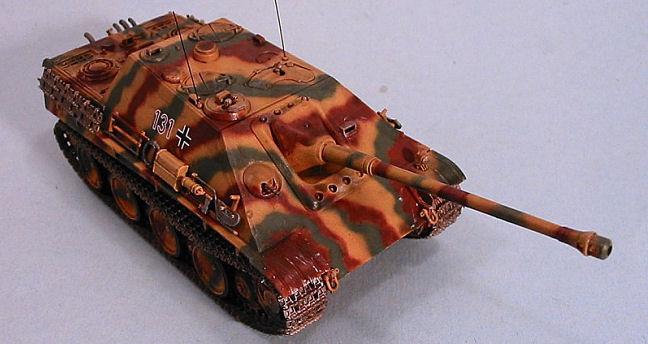
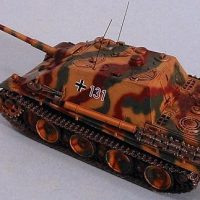
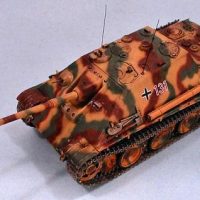
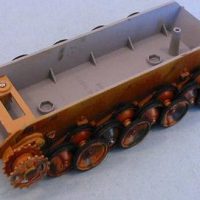
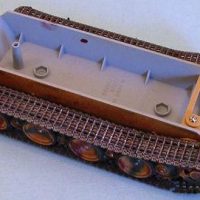



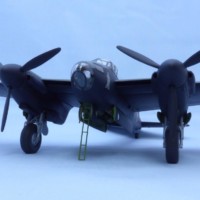
Great looking Jagdpanther. The Jagdpanther sure does look a lot like an enlarged version of the Hetzer and Panzer IV/70.
Really good loking, my friend @tcinla! Those quarter scale Tamiya armors are very attractive.
Slick looking vehicle and paint job. The kind of vehicle I would like to have to stay alive in Bay Area Traffic !
Thank you for the great painting tips on German armour.
@bernardbedeur - I lived in the Bay Area so long ago I can remember it taking only 45 minutes to get from San Francisco State over to my research job at Cal Berkeley. 🙂
I can also remember when I first came to Los Angeles and "rush hour" was only... an hour. 🙂
I cannot say the years since then have been all that "progressive."
Yes. At least in Los Angeles they know how to use and share the road. Not as good as Bostonians or Parisians but next best. Here, there are few courteous drivers Left it seems and with all the souped up Racers And low enforcement on wonders...
I wanted to ask what the equivalent brand is for, or what to use as « future« floor polish /varnish in California and what works.
Some tracked Armoured vehicles are road legal in California..makes the jagd -Panther all the more seductive!
Thank you for the great reads.
@bernardbedeur - In California, Future is "Pledge Floor Care Multi-Surface Finish." If you can't find it otherwise, the bottle is the same size as the old Future and it looks like Future inside.
Wheel painting may be tedious but it's such a large part of the finished result.
Worth every minute of it if you ask me.
Beautiful.
It's getting the "tedious stuff" right that separates a "winner" from an "also-ran." It's always the little stuff that matters.
Look great! I like this scale of armor.